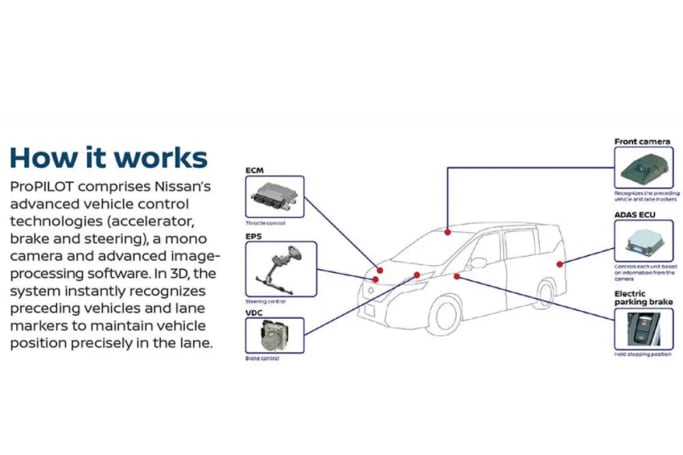
Isuzu MU-X LS-T 2024 review: snapshot
The LS-T is the flagship the 2024 MU-X range, offered exclusively with the...
Browse over 9,000 car reviews
The new Nissan Serena could be the Japanese car-maker's most important vehicle never to come to Australia. Richard Berry tests and reviews Nissan's Serena people mover, equipped with ProPilot autonomous driving technology, at its International launch in Yokohama, Japan.
The Serena people mover is Nissan's first self-driving car and it's recently gone on sale in Japan. It's not coming here, but Australians aren't going to miss out on its autonomous technology. It will be coming to a car in Nissan's local range, and in the lead up Nissan gave us a quick taste of the new self-driving tech in the Serena at a test track in Japan.
So, is the technology as good as that already offered by prestige brands such as Tesla and Mercedes-Benz?
Nissan's calls the self-driving tech ProPilot and it's an option in the top-spec seven-seat Serena. In Japan there were 30,000 orders placed for the fifth generation Serena before it went on sale and more than 60 percent of customers are ticking the ProPilot option box.
On the back of that success, the company's global head of marketing and sales, Daniele Schillaci said the plan is to roll the technology out around the world.
"We aim to expand ProPilot globally by adapting it to core models in each region," he said.
"We'll also introduce Qashqai – a European bestseller - with ProPilot in 2017. Nissan will launch more than 10 models with ProPilot in Europe, China, Japan and the US."
Nissan Australia is tight lipped on which vehicle will feature ProPilot locally, but it is known the technology will be available in the right-hand drive 2017 Qashqai in the United Kingdom.
The Qashqai compact SUV is Nissan's third best-selling vehicle in Australia behind the Navara ute and X-Trail SUV.
It's mobility for everybody with total peace of mind.
More affordable brands like Nissan developing and equipping their vehicles with the technology means self-driving cars are no longer a luxury. Schillaci calls it intelligent mobility and says it will be benefit for everybody, particularly those unable to drive because of disability.
"In the future we'll make the car a partner for our customer giving them more comfort, confidence and control," he said.
"Those people who don't have access to transport because they might be blind or older people who can't drive because of limitations - the technology will probably solve this problem, too. This is one of the directions that we are pursuing – it's mobility for everybody with total peace of mind."
Those are encouraging and ambitious words, but in reality how good is the technology right now? That's what we wanted to test out.
Nissan's ProPilot system currently only works in a single lane. It's more or less active cruise control with added steering. By 2018 Nissan plans for ProPilot to be able to change lanes autonomously on a motorway, and by 2020 the company believes the system will be able to guide a vehicle safely through an urban area, including intersections.
We were only given two five-minute drives around a track at a Nissan testing facility in Japan, so it's almost impossible to say how well ProPilot will work in the real world.
Following a lead vehicle in our Serena at 50km/h the system was easy to engage by pushing the ProPilot button on the steering wheel. The driver then selects the distance they'd like to keep from the car in front and presses the Set button.
A grey steering wheel on the display means the system is not ready to take over the driving, but when it turns green the vehicle begins driving itself. It will follow the car in front and keep itself in its lane.
When the lead car stopped so did my Serena, then when it moved away so did my vehicle. Seamlessly. Perfect for bumper-to-bumper traffic where the risk of a rear-ender escalates.

I was impressed by the minute changes the car made to the steering on a straight part of the track as the bumps and undulations moved it slightly off course; just like a driver does when steering their own car.
I was also impressed by the system's ability to stay in its lane in corners which turned through almost 360 degrees.
If there is no vehicle ahead the system will still work, but not below 50km/h.
The large screen displaying the self-driving information is easier to read than the display used by Tesla where the little grey steering wheel is hidden in near the speedo.
The ProPilot system uses a single high-resolution monocamera which identifies cars and lane markings.
Tesla and Mercedes-Benz use an armoury of sonars, radars and cameras. But the Benz and Tesla are far more autonomous, and having driven the Model S P90d and the new E-Class we also know they have their limitations – tight corners on roads that aren't marked clearly often quickly disengage the system and leave the driver having to take over.
ProPliot surely would have similar issues and limits – but we won't know until we take it on real roads.
Comments